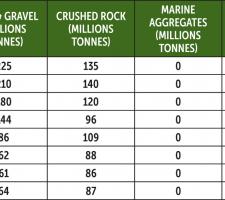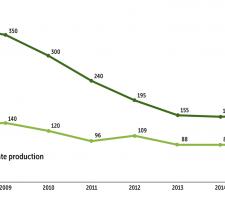
Aggregates demand in Italy is slowly recovering but economic and political uncertainty is not helping its progress, as Guy Woodford reports.
Aggregates demand has remained low in Italy ever since the global financial crisis hit in 2008. While demand is slowly recovering, particularly in the north of the country, it’s from a very low point, with few major infrastructure projects digger-ready. Furthermore, the political events of recent weeks, coupled with a bleaker national economic forecast, will have done nothing to encourage aggregates material suppliers’ hopes of more rapid growth.
Paolo Gentiloni is Italy’s new Prime Minister, after former PM Matteo Renzi lost the country’s constitutional reform referendum on 4 December 2016. However, just a month after being sworn in, 62-year-old Gentiloni fell ill and was rushed to hospital where he underwent emergency heart surgery. While he was, at the time of writing, making a good recovery, Gentiloni’s delicate health acts as a fitting metaphor for the fragile state of growth within his country’s aggregates industry.
January 2017 also saw the International Monetary Fund (IMF) cut its growth forecasts for Italy for 2017 and 2018. It expects Italy’s GDP to rise 0.7% this year, down 0.2% from its October 2016 estimate. It sees growth of 0.8% in 2018, down 0.3% on the previous forecast. The IMF gave the figures as it updated its World Economic Outlook. It said the Italian economy grew by 0.9% in 2016. IMF chief economist Maurice Obstfeld has called on Italy to do more for its troubled banking sector, including tackling the issue of non-performing loans.
While Italy has its political and fiscal issues, given the country’s 150 million tonnes plus annual aggregate production output, it remains an important European market for quarrying equipment OEMs, such as Volvo Construction Equipment, a leading player in the international loading and hauling model market.
“The Italian aggregates sector is slowly recovering after a long and deep depressed period,” says Stefano Tacchinardi, managing director of
Speaking of Italian aggregate demand in the next couple of years, Tacchinardi says: “It will not significantly grow in the next two years, as investments in civil works such as roads and public buildings are not significantly expanding; this is due to constraints on Italian debt. The real estate market is therefore also not expected to have a strong recovery in the next two years.”
Tacchinardi points to high-speed train prolongation, new motorways, earthquake repairs and a school refurbishment programme as being among the most important future Italian infrastructure projects.
He also offers some encouragement in terms of quarrying and construction equipment unit sales, and welcomes moves towards greener minerals material production.
“During the last year, the market has allowed for a new wave of replacements for obsolete machinery; this has been a key factor for the new growth. Public subsidies (primarily 140% fiscal depreciation) favoured this process.
“The case for environmentally friendly production is growing, with many municipalities and contractors asking for it in their tenders.”
Global crushing and screening giant
“2015 aggregates demand in Italy was approximately 156 million tonnes per year. We presume that in 2016 it will be the same,” says Pekka Pohjoismaki, senior vice president Europe, Metso Mining and Construction. “The real estate sector is restarting a bit again, but not for new buildings, just for restoring old existing ones. Demand for second houses (holiday houses) dramatically plunged years ago due to new heavy taxes and has not restarted. We could estimate that 60% of aggregate demand is coming from the north, while 40% from the south.”
Pohjoismaki notes that while Italian GDP pro capita has lost 10.4 percentage points in the last eight years, with some southern regions dropping by 13/15%, there were modest signs of recovery in 2016, ranging from + 0.3% in the southern region of Calabria, to +1.1% in Emilia Romagna in the north.
Of major infrastructure projects likely to influence Italian aggregate demand levels, Pohjoismaki says quarries set to supply aggregate materials for the COCIV project – the high-capacity railway line between Genoa and Milan – have already been identified and equipped. Meanwhile, the proposed Turin–Lyon high-capacity railway line is in the early planning stage. Pohjoismaki describes it as a very long-term project with a “lot of political conflicts”.
“There has been a reduction of demand in Italy for sand and aggregates for concrete because of the decrease in concrete demand. Demand for aggregates for asphalt is quite stable,” adds Pohjoismaki. “Italian producers are quite sensitive to green production, but recently there’s been more interest in automated innovation systems.”
Ahead of the showpiece event, a report from SaMoTer-Veronafiere Outlook (SVO) revealed that 7,551 construction machines were sold in Italy from January-September 2016 - up 32% from the same period in 2015. SVO, a construction sector observatory developed in partnership with international consultant Prometeia, with the support of Unacea, the Italian Association of construction machinery and equipment builders, also estimated an increase of 37% in construction unit sales in Italy in the period 2017-2018, compared to 2015-16.
Unacea says that while it welcomes construction equipment sales growth recorded over 11 consecutive quarters, Italy still has to recoup losses in a sector that, following the economic crisis in 2008, shrank by more than 80%.
As part of a global rise in construction equipment forecasted for the next two years, SVO predicts that earthmoving machinery in Italy will continue along a recovery path started in 2014, leading to 15,600 units being sold in 2018 - up 37% on 2016 sales - while generating a European market share of 10%.
It seems the rise, however slow and small, in aggregate demand, and a more encouraging rise in construction equipment sales, generally linked to new infrastructure projects, is offering some hope of brighter times ahead for Italian aggregate producers.










